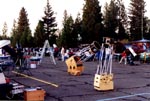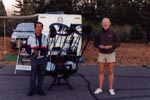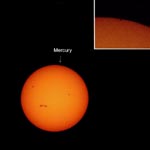
These photos were taken from my second Star Party at Blue
Canyon. Also with me on that day
was my dad, who came to US to visit me.
Apart from taking astrophotography, I also have the opportunity
to take several photos of the site.
Take a look at these arrays of giant telescopes.
Every month, amateur astronomers
from the Sacramento Valley Astronomical Society have their
Star Party at Blue Canyon. They
bought about 20 to 30 telescopes.

Giant binocular-telescope built
by Bruce (right)

My dad posing beside my telescope.
ASTROPHOTOS
The
below images were taken with the same setup as the one on my first star
party
on 11th Sept 1999. If you have any questions, pls write to me
cklim@pcocd2.intel.com
CYGNUS with 50mm F2.8.
DOUBLE CLUSTERS with 200mm F6, 30mins exposure.
M22, a globular cluster in Sagittarius. The cluster
is not really resolved into
into thousand of stars in this photo taken with
200mm F6 and 30mins
exposure.
ANDROMEDA GALAXY, M31.
You should see the original photo. You can make
out the dust lanes from the photo easily.
This is a 200mm F6 with 45mins exposure.
PLEIADES, M45.
This is a 45mins exposure with 200mm F6. The
blue nebulosity of the cluster was quite
apparent in this photo compared with the one
I took in September.
NORTH AMERICAN NEBULA (NGC7000)
Too bad. This is one of favorite object and it
is the only photo which shows bad star trails!
But I'm quite happy with the result. 200mm F6
with 45mins exposure.
CONSTELLATION OF ORION
50mm F4 with 30mins exposure.
STAR TRAILS
This is my longest star trails exposure that
I have taken so far. I sst my camera towards the north
and expose the film for 1 hour and 15mins. The
trails were cause by the rotation of the Earth. The
star that is almost pin point and center of the
circle is Polaris, the North star.

TRANSIT OF MERCURY
Ok, this photo was not taken from Blue Canyon.
This is a image of the Sun on 15th Nov 1999. On that day,
the planet nearest to the Sun, Mercury, moves
across the disc of the Sun. It appeared as a dark dot near the
edges of the Sun. On that day, you can also see
giant sunspots. These sunspots are big, I mean really big. You
would be able to see them with your naked-eye
if you have proper filter.